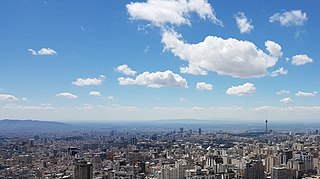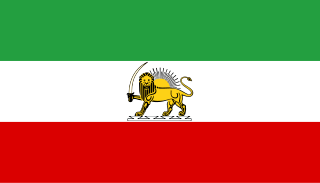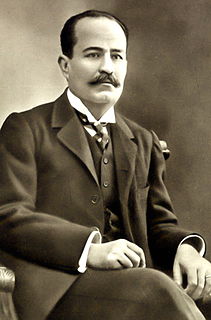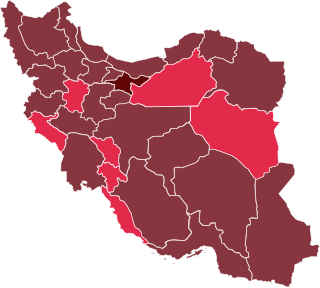
Persian, also known by its endonym Farsi, is a Western Iranian language belonging to the Iranian branch of the Indo-Iranian subdivision of the Indo-European languages. It is a pluricentric language predominantly spoken and used officially within Iran, Afghanistan and Tajikistan in three mutually intelligible standard varieties, namely Iranian Persian, Dari Persian and Tajiki Persian. It is also spoken natively in the Tajik variety by a significant population within Uzbekistan, as well as within other regions with a Persianate history in the cultural sphere of Greater Iran. It is written officially within Iran and Afghanistan in the Persian alphabet, a derivation of the Arabic script, and within Tajikistan in the Tajik alphabet, a derivation of Cyrillic.

Iran, also called Persia, and officially the Islamic Republic of Iran, is a country in Western Asia. It is bordered to the northwest by Armenia and Azerbaijan, to the north by the Caspian Sea, to the northeast by Turkmenistan, to the east by Afghanistan and Pakistan, to the south by the Persian Gulf and the Gulf of Oman, and to the west by Turkey and Iraq. Its central location in Eurasia and proximity to the Strait of Hormuz give it significant geostrategic importance. Tehran is the capital and largest city, as well as the leading economic and cultural hub; it is also the most populous city in Western Asia, with more than 8.8 million residents, and up to 15 million including the metropolitan area. With 83 million inhabitants, Iran is the world's 17th most populous country. Spanning 1,648,195 km2 (636,372 sq mi), it is the second largest country in the Middle East and the 17th largest in the world.

The Iran–Contra affair, popularized in Iran as the McFarlane affair, the Iran–Contra scandal, or simply Iran–Contra, was a political scandal in the United States that occurred during the second term of the Reagan Administration. Senior administration officials secretly facilitated the sale of arms to the Khomeini government of the Islamic Republic of Iran, which was the subject of an arms embargo. The administration hoped to use the proceeds of the arms sale to fund the Contras in Nicaragua. Under the Boland Amendment, further funding of the Contras by the government had been prohibited by Congress.

The Iran–Iraq War was a protracted armed conflict that began on 22 September 1980 when Iran was invaded by neighbouring Iraq. The war lasted almost eight years, ending in a stalemate on 20 August 1988 when Iran accepted a UN-brokered ceasefire. Iraq's rationale for the invasion was primarily to cripple Iran and prevent Ayatollah Ruhollah Khomeini from exporting the 1979 Iranian Revolution movement to Shia-majority Iraq and threaten the Sunni-dominated Ba'athist leadership. Iraq had also wished to replace Iran as the dominant state in the Persian Gulf, which had not been previously possible due to pre-revolutionary Iran's goliath status in both economic and military terms as well as its close alliances with the United States and Israel. The war followed a long-running history of border disputes, as a result of which Iraq had planned to annex Iran's oil-rich Khuzestan Province and the east bank of the Shatt al-Arab.

Sayyid Ruhollah Musavi Khomeini, also known in the Western world as Ayatollah Khomeini, was an Iranian politician, revolutionary, and cleric. He was the founder of the Islamic Republic of Iran and the leader of the 1979 Iranian Revolution, which saw the overthrow of the last Shah of Iran, Mohammad Reza Pahlavi, and the end of the 2,500-year-old Persian monarchy. Following the revolution, Khomeini became the country's Supreme Leader, a position created in the constitution of the Islamic Republic as the highest-ranking political and religious authority of the nation, which he held until his death. He was succeeded by Ali Khamenei on 4 June 1989.

Zoroastrianism or Mazdayasna is one of the world's oldest continuously practiced religions. It is a multi-faceted faith centered on a dualistic cosmology of good and evil and an eschatology predicting the ultimate conquest of evil with theological elements of henotheism, monotheism/monism, and polytheism. Ascribed to the teachings of the Iranian-speaking spiritual leader Zoroaster, it exalts an uncreated and benevolent deity of wisdom, Ahura Mazda, as its supreme being. Historical features of Zoroastrianism, such as messianism, judgment after death, heaven and hell, and free will may have influenced other religious and philosophical systems, including Second Temple Judaism, Gnosticism, Greek philosophy, Christianity, Islam, the Bahá'í Faith, and Buddhism.

Tehran is the capital of Iran and Tehran Province. With a population of around 8.7 million in the city and 15 million in the larger metropolitan area of Greater Tehran, Tehran is the most populous city in Iran and Western Asia, and has the second-largest metropolitan area in the Middle East. It is ranked 24th in the world by the population of its metropolitan area.

Ali Daei is an Iranian former professional footballer, football manager and businessman. A striker, he was captain of the Iran national football team, and played for clubs such as Bayern Munich and Hertha BSC. He is currently the owner and CEO of Daei Sport.

The Iran national football team, also known as Team Melli, represents Iran in international football and is controlled by the Iran Football Federation. From December 2014 until May 2018, the men's national football team of Iran remained the highest-ranked team in Asia, representing the longest continuous period of time a team has been top of the continent in the rankings.

The Imperial State of Iran, also known as the Imperial State of Persia from 1925 to 1935, was a country in Western Asia. It was ruled by the Pahlavi dynasty, the last ruling house of Iran, from 1925 until 1979, when the Persian monarchy was overthrown and abolished as a result of the Islamic Revolution. The dynasty was founded by Reza Shah Pahlavi in 1925, a former brigadier-general of the Persian Cossack Brigade, whose reign lasted until 1941, when he was forced to abdicate by the Allies after the Anglo-Soviet invasion of Iran. He was succeeded by his son, Mohammad Reza Pahlavi, the last Shah of Iran.

The Iranian Revolution was a series of events that culminated in the overthrow of the Pahlavi dynasty under Shah Mohammad Reza Pahlavi—who was supported by the United States—and the replacement of his government with an Islamic republic under the Grand Ayatollah Ruhollah Khomeini, a leader of one of the factions in the revolt. The revolution was supported by various Islamist and leftist organizations and student movements.

Sayyid Ali Hosseini Khamenei is a Twelver Shia Marja' and the second and current Supreme Leader of Iran, in office since 1989. He was previously President of Iran from 1981 to 1989. Khamenei is the longest serving head of state in the Middle East, as well as the second-longest serving Iranian leader of the last century, after Shah Mohammad Reza Pahlavi.
The Barmakids ; also spelled Barmecides, were an influential Iranian family from Balkh where they were originally hereditary Buddhist leaders, and subsequently came to great political power under the Abbasid caliphs of Baghdad. Khalid, the son of Barmak became the chief minister (wazir) of Al Saffah, the first Caliph of the Abbasid dynasty. His son Yahya aided Harun Al-Rashid in capturing the throne and rose to power as the most powerful man in the Caliphate. The Barmakids were remarkable for their majesty, splendor and hospitality. They are mentioned in some stories of the One Thousand and One Nights.
Ja'far ibn Yahya Barmaki, Jafar al-Barmaki (767–803) also called Aba-Fadl, was a Persian vizier of the Abbasid caliph Harun al-Rashid, succeeding his father in that position. He was a member of the influential Barmakid family, formerly Buddhist leaders of the Nava Vihara monastery. Along with the rest of the Barmakids, he was executed in 803 at the orders of Harun al-Rashid. It is said that his execution was for allegedly having had an affair with Harun's sister Abbasa, although historical sources remain unclear.

Mohammad Reza Pahlavi, also known as Mohammad Reza Shah, was the last Shah (King) of Iran from 16 September 1941 until his overthrow in the Iranian Revolution on 11 February 1979. Due to his status as the last Shah of Iran, he is often known as simply the Shah.

The Persian Empire or Imperial Iran is any one of the many imperial dynasties centred in Iran (Persia) from the 6th century BC, the Achaemenid Empire, to the 20th century, the Pahlavi dynasty.

Jurji Zaydan was a prolific Lebanese novelist, journalist, editor and teacher, most noted for his creation of the magazine Al-Hilal, which he used to serialize his 23 historical novels.
Abbasa was an Abbasid princess.

Abbasa is a village in Natel Kenar-e Olya Rural District, in the Central District of Nur County, Mazandaran Province, Iran. At the 2006 census, its population was 2,380, in 562 families.

The COVID-19 pandemic in Iran is part of the worldwide pandemic of coronavirus disease 2019 caused by severe acute respiratory syndrome coronavirus 2. On 19 February 2020, Iran reported its first confirmed cases of infections in Qom. The virus may have been brought to the country by a merchant from Qom who had travelled to China.














